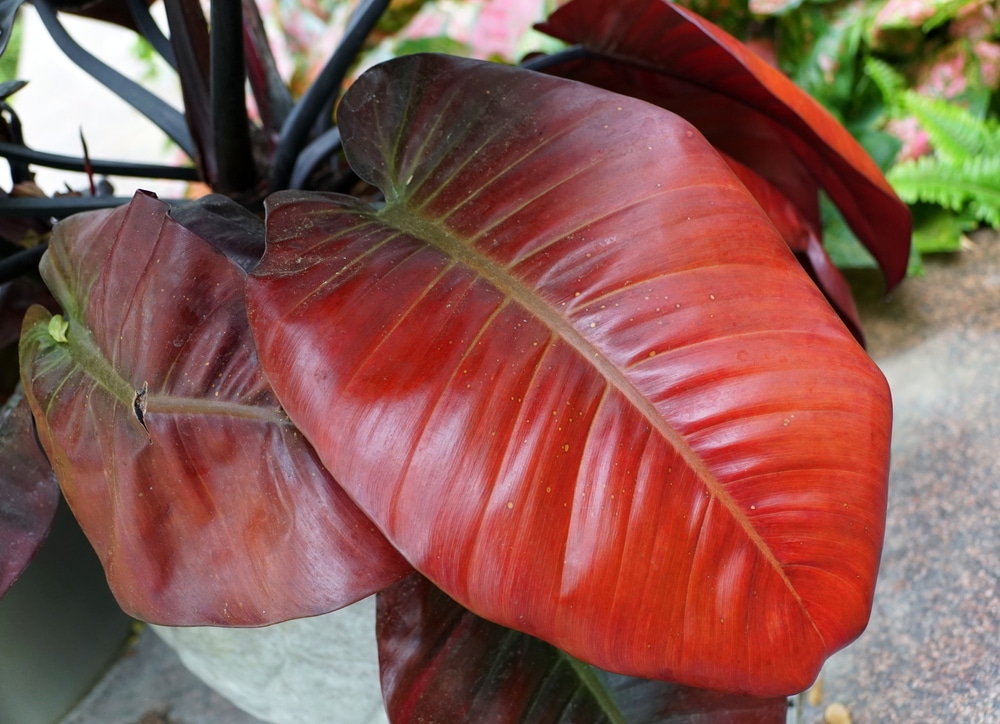With so many species of Philodendron out there, it can be difficult to choose which one to bring home. It’s a genus filled with gorgeous varieties of all sizes and colors, from compact houseplants to winding, stretching climbers. Still, if you have to choose only one, Philodendron erubescens ‘Black Cardinal’ is a strong contender. This hybrid’s glossy, dark foliage sets it apart from the crowd, both from other philodendrons and from other house plants in general.
While the Black Cardinal doesn’t occur completely naturally, it is a cross of several legitimate Philodendron species. It can be traced back to the tropical environments of Central and South America and has taken on several desirable traits from other species. It’s compact, not reaching the massive heights of some related species, so it’s ideal to bring into your home. You won’t need to set aside too much space for it.
Philodendron erubescens ‘Black Cardinal’ isn’t rare, per se, but they can be difficult to find due to mislabeling. The species takes a while to mature and doesn’t always have its tell-tale dark coloration, leaving room for other varieties to masquerade as a Black Cardinal instead. Get your hands on a genuine Philodendron erubescens ‘Black Cardinal’ for a real treat!
| Common Name | Black Cardinal, |
| Botanical Name | Philodendron erubescens ‘Black Cardinal’ |
| Native Area | Central and South America |
| Sun/Light Requirements | Bright, indirect light (low-light tolerant) |
| Water | Moderate |
| Soil | Well-draining, airy, slightly acidic |
| Temperature | 55°F to 80°F |
| Humidity | 40% minimum (70% for optimal growth) |
| Hardiness Zones | USDA Zones 10 to 11 |
Philodendron Black Cardinal Appearance

Philodendron erubescens ‘Black Cardinal’ earned its name because of its dark leaves. They range from deep red to almost entirely black. As the plant grows and matures, you’ll see varying shades of deep, dark green, purple, red, and black. You may even notice some bronze leaves during different phases of growth. If you’re tired of standard green plants – a Black Cardinal is the answer you seek.
Their long leaves are glossy but have a thick leather-like feeling when you touch them. They can grow up to a foot long and are quite wide, so you’ll have little choice but to notice them! Black Cardinals are self-heading, too, which means all their leaves come from the center of the plant. It doesn’t climb and it isn’t a vine. All that dramatic, beautiful color comes right from the middle of the plant and stays in one place.
A Philodendron erubescens ‘Black Cardinal’ grows up to around three feet in height – hardly the largest species out there. It’s a slow grower, too, so you’ll need to exercise a bit of patience before you see it grow to its full height. Fortunately, most species of Philodendron have long lifespans (around twenty years or more), so there’s plenty of time to wait it out!
Philodendron Black Cardinal Care Requirements
This hybrid was specifically bred to be low-maintenance and easy to care for. Considering how striking it is, that makes it a very attractive plant for serious collectors and beginners alike. As long as you remember it exists and needs watering occasionally, you’re qualified to care for it!
Sun/Light Requirements
The Philodendron Black Cardinal was bred to tolerate low-light levels, so theoretically it will do fine even tucked away in an office. However, if you want to keep its attractive colors vibrant, go for bright, indirect light instead. Since its parent species live under the dense rainforest canopies of Central America and South America, this plant requires the same sort of dappled, filtered sunlight for optimal growth.
Still, it can tolerate a range of lighting conditions. The only thing you want to avoid completely is placing it in the full, direct path of the sun. Direct sunlight will harm your plant and damage the leaves. Low light will merely inhibit its already slow growth, but too much sun will harm it quickly.
Water
Keep things moist for your Philodendron erubescens ‘Black Cardinal’ but don’t stray into the soggy territory. These plants enjoy being watered moderately often. Test your soil and water once the top two inches of soil are dry.
Make sure the container has plenty of drainage holes, as you don’t want to leave this plant sitting in water. Being waterlogged or trapped in soggy soil will choke the roots and put them at high risk for root rot. If you’ve cared for any other Philodendron species, you’ll know that the whole genus is susceptible to fungal infection on root rot, so do what you can to keep your plant safe.
Soil
When you’re choosing the right soil for any plant, it’s important to consider where they came from. In the case if Philodendron erubescens ‘Black Cardinal’, that means dense, lush rainforest floors. They’re rich in organic matter, and that’s precisely the type of soil this plant craves.
Moist, slightly acidic soil with plenty of nutrients and drainage is critical for the healthiest plant possible. Peat moss, orchid bark, and perlite are solid choices. Keep things light, airy, and well-draining. For instance, African violet mix combined with peat moss or sphagnum moss mimics the aerated, springy rainforest floor environment.
Temperature
Other than avoiding particularly cold temperatures, your Philodendron Black Cardinal will be happy with most temperatures. Standard household settings suit it fine, as long as they stay between 55°F and 80°F. It doesn’t stand up well to cold temperatures or frost, though, so if it’s going to be in weather lower than 50°F, bring it inside!
Humidity
High humidity helps with healthy growth, and Philodendron erubescens ‘Black Cardinal’ does great with higher levels. Stay around 70% for optimum growth and lively, vibrant colors. 40% to 50% humidity levels are acceptable, though, as this plant is adaptable.
Other Philodendron species have very similar requirements, so if you have more in the collection just add this one into their space. Keeping multiple plants together helps maintain humidity levels, anyway, so it’s a double win!
If you’re struggling to keep up with its humidity requirements, pick up a humidifier or set up a pebble tray filled with water. Daily misting helps a lot, too, just make sure you’re using clean water to avoid introducing bacteria.
Fertilizer
During the growing months (spring and summer) use a balanced liquid feed. Dilute it to half-strength and feed your plant once per month. Be careful not to over-fertilize and damage the plant with fertilizer burn.
Pruning Your Philodendron Black Cardinal
These self-heading plants don’t need much help in the pruning department. The leaves grow closely together from the same space, so you won’t see much wild or odd growth. It is important to remove dead or diseased parts of the plant, though, so it doesn’t sink energy into something that can’t be saved. Carefully cut away any discolored or dead leaves with a pair of clean shears.
You can prune the plant to keep it smaller. They only grow to around three feet tall, but you can trim back excess growth if you want the plant to stay smaller.
Philodendron Black Cardinal Propagation
The patent for this hybrid plant expired several years ago, so it’s perfectly safe to propagate your own at home. You can do so by using stem cuttings. Since Philodendron erubescens ‘Black Cardinal’ is a self-heading plant, that can be a bit easier said than done, however. It can be a hassle to get a good stem cutting when you can’t easily reach the stem!
Instead, wait until you’re repotting the plant and propagate by division instead. As you’re repotting, separate sections away from the mother plant. You can cut into the roots if necessary, but take care not to damage too much of the system as you separate your new plant.
Once you’ve divided your plant, place each new section in its own pot with your soil mixture, keep it moist, and care for it as usual!
Repotting A Philodendron Black Cardinal
Philodendron erubescens ‘Black Cardinal’ doesn’t grow quickly, so you won’t have to repot it often. Count on doing it every two or three years, though. You’ll know it’s time when the plant becomes rootbound and you start seeing roots on top of the soil or through the bottom of the drainage holes. Go one size up when you repot and take care not to damage the roots!
Pests and Disease
These hybrid beauties are relatively pest-resistant, but you could still have some issues with aphids, mealybugs, and fungus gnats. The best way to prevent these pests is to avoid overwatering your plant. Wiping down the leaves regularly helps, too, as it prevents them from settling in.
If you see any signs of pest activity, remove the affected leaf (or leaves) from the plant and wipe the others clean. Treat the plant with neem oil or horticultural soap.
By far, the most common disease for the Philodendron Black Cardinal is root rot. Overwatering is the number one cause, so do a soil test every time you think it’s time to water!
Final Thoughts
Dare to be different with the Philodendron erubescens ‘Black Cardinal.’ Its dark, alluring foliage brings depth to any room and bucks against the usual sea of green that house plants offer. With such easy care requirements, there’s no good reason to refuse!

